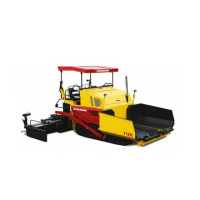B 5
B_F121C_F141C_02_GB.fm 5-24
Levelling system/slope control system: The slope control system (option) allows
the traction point to be regulated at the left-hand or the right-hand side with a defined
difference to the opposite side.
To determine the actual value, the two traction arms are linked with a slope control
rod.
The slope control system always operates in conjunction with the screed height ad-
justment of the opposite side.
By adjusting the height of the traction point of the arm (traction roller), the paving
height of the material or the laying height of the screed can be controlled.
Actuation occurs electro-hydraulically on both sides and can be controlled manually
by means of toggle switches or automatically by means of an electronic grade control
system.
The screed lifting system: The screed can be lifted to transport height using the
screed lifting system. Lifting occurs electro-hydraulically on both sides by actuating
the hydraulic cylinders on the arms and is controlled by means of toggle switches on
the operating panel.
Automatic screed stop and screed charging/relieving device: The automatic
screed stop prevents the screed marks caused by a stopped screed. When the paver
is stopped (changing trucks), the screed remains in floating position and the relieving
pressure is turned on, therefore, the sinking of the screed can be avoided while
stopped.
The screed relieving device puts a higher load on the chassis, thus increasing the
traction.
Activating the screed charging device can improve the compacting result under cer-
tain conditions.
Exhaust of asphalt vapours (o): The asphalt vapours are extracted by a hydrauli-
cally driven exhaust head mounted in the material tunnel or over the auger. The va-
pours collected are discharged together with the exhaust fumes of the internal
combustion engine.
Central lubrication unit (o): The central lubrication pump fitted with a large lubricant
tank supplies grease to the various lubrication circuits through various flow dividers.
They supply lubricant to the service-sensitive points of lubrication (e.g. bearings) by
adjustable intervals.

